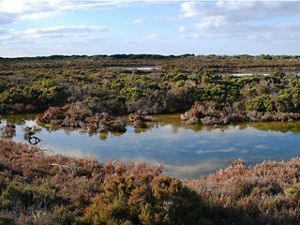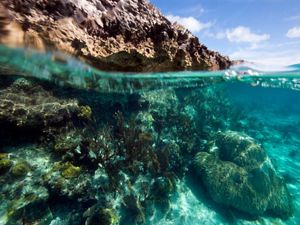A smart way forward for blue carbon in South Australia
Fighting climate change through blue carbon

Blue Carbon is CO2 that is captured by coastal wetlands mangroves, salt marshes and seagrasses. It can remain in the sediment for thousands of years, making it one of the most powerful natural solutions to climate change.
According to the ABS, in 2021 mangroves and seagrass combined provided up to 14.2 million tCO2e carbon sequestration services per year. If these wetlands are naturally able to migrate with changing sea level rather than being drained or trapped – ecosystems in Victoria alone could store 1.6 million tonnes of carbon by 2050 with a value of $65 million.
Sadly, coastal wetlands are rapidly disappearing worldwide. They are being converted for agriculture, aquaculture and urban development. We aim to protect and conserve our southern coastal wetlands as a way to fight climate change.
A smart partnership for blue carbon
The Nature Conservancy Australia, the South Australian Government and Smartgroup have partnered to secure a new site for the Adelaide coastal wetlands restoration project. They have worked with coastal ecologists to seek a site that will have the biggest impact for the local environment as well as carbon capture and storage.
Smartgroup, a leading provider of salary packaging and novated car leasing, is one of the first Australian companies to invest in a blue carbon project. This partnership carbon offset program through a new blue carbon project in South Australia. Partnering with The Nature Conservancy provides Smartgroup with an opportunity to support an important investment in carbon offsets in South Australia.
This blue carbon project will restore 256 hectares of mangrove and saltmarsh habitats at a Webb Beach site, 50km north of Adelaide. Over the next year the team will restore natural tidal flow to the wetlands, which will expand the area where mangroves and saltmarsh can grow.
The project will have many conservation benefits, including protecting threatened species, tidal retreat, the creation of fish habitat and important Australian and migratory shorebirds roosting and feeding habitat.
Quote: Alison Rowe
South Australia’s coastal wetlands are of national biodiversity significance and provide vast opportunities to advance a blue carbon economy and help mitigate climate change.
MEDIA GALLERY:






A haven for shorebirds
The Webb Beach site adjoins the Adelaide International Bird Sanctuary National Park - Winaityinaityi Pangkara, a critically important habitat for many Australian and migratory shorebirds.
Around 15,000 shorebirds gather here each year before migrating to breeding grounds in China, Siberia and East Asia. Expanding this habitat will strengthen global conservation efforts along one of the world’s three great migratory bird flight paths.
The area supports the Eastern Curlew, Bar-tailed Godwit and Great Knot. The Bird Sanctuary also provides habitat for important birds like the Elegant Parrot and Gulf St Vincent Slender-billed Thornbill.

CO2 emissions in Australia
According to the Department of Climate Change, Energy the Environment and Water, Australia produced 535.7 million tonnes of carbon dioxide emissions this year. These came from various sectors however energy and transport contributed most of these emissions.
This partnership with Smartgroup is an important step towards a collaborative approach that will be necessary to stem the ongoing impact of climate change across Australia.




.JPG?crop=222%2C0%2C3556%2C2667&wid=300&hei=225&scl=11.853333333333333)